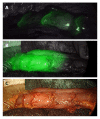Indocyanine green-based fluorescence imaging in visceral and hepatobiliary and pancreatic surgery: State of the art and future directions
- PMID: 30038461
- PMCID: PMC6054946
- DOI: 10.3748/wjg.v24.i27.2921
Indocyanine green-based fluorescence imaging in visceral and hepatobiliary and pancreatic surgery: State of the art and future directions
Abstract
In recent years, the use of fluorescence-guided surgery (FGS) to treat benign and malignant visceral, hepatobiliary and pancreatic neoplasms has significantly increased. FGS relies on the fluorescence signal emitted by injected substances (fluorophores) after being illuminated by ad hoc laser sources to help guide the surgical procedure and provide the surgeon with real-time visualization of the fluorescent structures of interest that would be otherwise invisible. This review surveys and discusses the most common and emerging clinical applications of indocyanine green (ICG)-based fluorescence in visceral, hepatobiliary and pancreatic surgery. The analysis, findings, and discussion presented here rely on the authors' significant experience with this technique in their medical institutions, an up-to-date review of the most relevant articles published on this topic between 2014 and 2018, and lengthy discussions with key opinion leaders in the field during recent conferences and congresses. For each application, the benefits and limitations of this technique, as well as applicable future directions, are described. The imaging of fluorescence emitted by ICG is a simple, fast, relatively inexpensive, and harmless tool with numerous different applications in surgery for both neoplasms and benign pathologies of the visceral and hepatobiliary systems. The ever-increasing availability of visual systems that can utilize this tool will transform some of these applications into the standard of care in the near future. Further studies are needed to evaluate the strengths and weaknesses of each application of ICG-based fluorescence imaging in abdominal surgery.
Keywords: Biliary anatomy; Biliary surgery; Fluorescence imaging; Gastrointestinal surgery; Indocyanine green; Liver surgery; Pancreatic surgery; Peritoneal carcinomatosis; Visceral perfusion.
Conflict of interest statement
Conflict-of-interest statement: Baiocchi GL, Diana M, and Boni L have received no funding and declare no conflicts of interest in relation to this specific work. Baiocchi GL received a travel grant from Stryker and from Karl Storz and has been the scientific organizer of the international workshop “Intraoperative ICG Fluorescence Imaging in Hepatobiliary and Visceral Surgery: State of the Art and New Frontiers,” (Brescia, Italy, October 21, 2017) partly funded (travel expenses) by Karl Storz and Stryker companies. Diana M is the recipient of a grant from the ARC Foundation (Project ELIOS) to develop fluorescence image-guided surgery. Boni L is a consultant for Storz and Olympus.
Figures




References
-
- Reinhart MB, Huntington CR, Blair LJ, Heniford BT, Augenstein VA. indocyanine green: historical context, current applications, and future considerations. Surg Innov. 2016;23:166–175. - PubMed
Publication types
MeSH terms
Substances
LinkOut - more resources
Full Text Sources
Other Literature Sources
Medical

